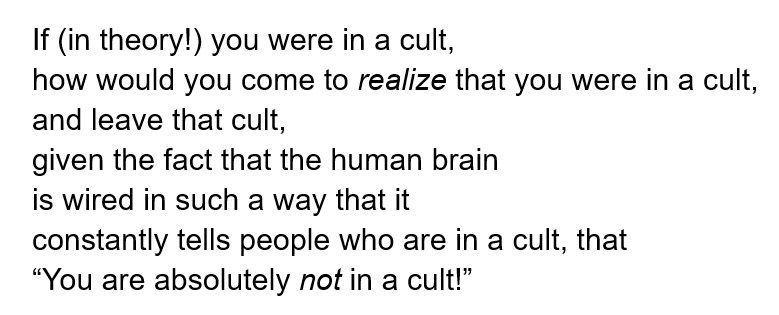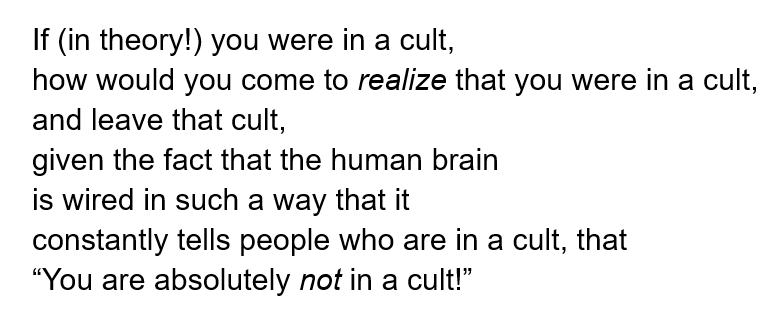For the first time ever in our blog’s 10-year history, we feature a series co-written by me, Gary Shogren; and our long-time friend, Tod Hannigan. Tod will do the heavy lifting on the philosophical end. Sign up for this blog if you want to get announcements when they come out, and we will keep a running list of all our posts on the topic.
Testing 4 Truth – Introduction
“If it feels true, it must be true, right?” #2
Gary says: Tod and I have been talking back and forth on this topic for la few years, and it seems more relevant today than it has in a long time. In fact, Tod – and to a lesser extent myself – have in the past concluded that we needed to break free of a religious group that was trying to control our thinking. So, we are depending on things we have observed, and supplementing them with useful articles on the topic.[1]
To start let’s be clear: many cults are religious (Jehovah’s Witnesses, but also groups that might have names that wouldn’t raise a red flag – Baptist, Pentecostal, International Churches of Christ, Light of the World/Luz del Mundo); others are anti-religious groups (in my opinion, some members of the New Atheism; Rajneesh was anti-religion; Jim Jones skewed atheist-socialist); UFO cults (Heaven’s Gate); or a social movement (the white supremacist group Creativity); but there are also political cults (the Black Guerilla Family, neo-Nazism among the more extreme; Maoism and Stalinism were as much about cults as they were about a political doctrine); even a cult that promises female empowerment but delivers exploitation (Nxivm, pronounced like NEX-ium; there are two documentaries about it).
A thought question:

There are plenty of groups that have cultic characteristics but whom I would not give the technical label of a cult. There are “cult-like” Republicans, Democrats, Socialists, Libertarians; Buddhists, Muslims, Ultra-Orthodox; etc. But it is the fact that there is a gray area between cults and “cult-adjacent” should keep every one of us on his or her toes.
LET’S LOOK AT TRAITS THAT DEFINE MANY CULTS:
Leadership
- A single leader or inner circle wields all authority.
- He – and it usually is a male – has a charismatic personality that lowers others’ defenses.
- Because his followers exalt him, he grows to feel himself above all other men. He sets himself up as the Alpha Male. His followers sense this self-confidence and give him even more adulation, creating a vicious circle.
- The leadership claims the right to define what is truth and what is not truth. In Christian cults, there may be a focus on the “Full Gospel” of Jesus Christ, which (coincidentally) has been revealed only to those inside the group. The lines between “God’s will” and the leader’s will are blurred.
- Loyalty to the leader is what defines “goodness.”
- If a cult has a governing board, it is not independent. It is stacked with insiders, employees, relatives of the leader. That is, the board has little freedom to disagree with or challenge the leader.
- The leader may claim to be humble, but his lack of accountability to other people is a sign of profound narcissism.
- A cult will refuse to make known its budget or financial reports, not even to Insiders.
- Members feel that there are things about the group that they are not allowed to discuss.
- Members are discouraged from challenging the leaders.
- Leaders lay down strict rules for the followers that they themselves do not follow: in the Love Has Won cult, alcohol was forbidden, but their leader was a raging and abusive drunk.
- Those who question the leaders are expelled or shunned, or humiliated in private or in front of the other members. Control over the members is shame-based.
- Leaders get involved in the details of the members’ lives, even to matters of money, dress, jobs, whom to marry.
- Leadership may rely on the powerful social norms of the group to bring new members into conformity. In religious groups there is a focus on asceticism (traditional “holiness standards”).
- Despite all of this, leaders insist that their followers are superior, strong, and the most independent of thought.
From Bad to Worse
Almost no cult starts off bad. Jim Jones’ Peoples Temple did not pass around the Kool-Aid until years after its founding. The Family (previously called the Children of God) was part of the broad Jesus Movement in the 1970s and only in the 80s became known for its sexual abuse of minors. In my experience, cultic leaders never get better on their own; they always get weirder over time. While I am reserved about naming the names of fellow evangelicals, two are likely cases: Jack Chick began as an author of booklets about the gospel, but over the years added a long stream of conspiracy theories about the Jesuits, Illuminati, the Vatican, condemning Christians who did not buy into his ideas as part of the enemy’s camp; we might also mention Harold Camping with his repeated, arcane calculations of the Second Coming and insistence that people leave their churches and follow only his teaching.
Group Boundaries
- There is a firm boundary between those who are In and Out of the group. Insiders “get it” or are “illuminated” or “woke”; Outsiders “just don’t get it” or are sheeple or worse, perhaps even demonic.
- Members are encouraged to socialize only with other Insiders; or they instinctively self-isolate from Outsiders.
- Because cults construct a black-and-white universe, they demand one’s exclusive allegiance.
- While reality is construed along the lines of True-versus-False, the reduction to Us-versus-Them may be a more important metric of reality: thus, “Whatever They say, just put a big NOT in front if it, and you can easily determine the truth.”
- Leaders use a specific Outsider as a punching bag: for Hitler, it was the Jewish international capitalists; Orwell’s Big Brother and Goldstein were thinly disguised versions of Stalin and Trotsky. The “Deep State,” the International Zionist Conspiracy, the Illuminati, a massive ring of anonymous pedophiles, or the New World Order are common – and unproven – constructs of today. And the names of real people or entities – Bill Gates, NASA, the Catholic Church, George Soros – are common devils. In nations with a heavy Christian population, the faithful are pulled in by mixing the new message with Christ-language: “Our group is What Jesus Would Do!”
- Leaders regularly “demonize” Outsiders for being stupid, out of touch with reality, morally depraved, “missing the mark,” or “just not getting it.”
- Outsiders are not said to reject the group’s message because they honestly find it unconvincing – rather, they are accused of harboring a deep, personal hatred of the leader and for that reason alone they reject his message.
- Members are constantly reminded that, even if it doesn’t seem to be so, all the Outsiders hate all the Insiders and would destroy them if they could.
- Leaders “project” their own anger, hatred, intolerance on the Outsiders. “Psychological projection is a defense mechanism in which the human ego defends itself against unconscious impulses or qualities (both positive and negative) by denying their existence in themselves while attributing them to others.” The anger of Insiders is justified since it is (supposedly) minuscule in comparison with the fury of the Outsiders.
- If a member is tempted to think that there are alternative views, other than that of the cult, they are constantly told that there are none, or that those views are obviously inferior.
- Paranoia is a common companion. “They” are about to arrest us, shut us down, take our money, send us to prison.
Power Structure
- Family structure erodes in favor of inner group leadership. If the leader is not called “Father,” he may be given some other unique title of power or affection. In Love Has Won, the leader was called Mother God or just Mom. Male leaders are idolized or sexualized by women. Female members, whether adults or not, might openly or secretly serve as the “harem” for the leader and a few favored men. Warren Jeffs of the FLDS is a case study in this realm.
- Members are implicitly ranked according to their approval by the leader(s). Members intuitively sense where they stand on this pyramid. Personal photo ops with the leader are highly valued.
- Anyone with special access to the leader wields power in a cult, especially if that lieutenant is his authoritaive spokesman. A prime example was Ma Anand Sheela in Rajneeshism.
- Members are encouraged to avoid higher education and are told to prioritize group meetings over attending classes or working on homework. Christian cults or sects might misuse the verse, “The fear of the Lord is the beginning of knowledge” in order to demonize learning.
Meetings and Communication of the Message
- If the doors are open or rallies are called, members are expected to be there.
- In meetings of Insiders (and the larger the group the better), individual resistance to the message is worn down by the constant messaging of the group’s doctrine.
- Speakers or leaders of meetings are carefully vetted, so that only the pure dogma of the group is communicated.
- Gatherings include chanting, singing, repetition, harangues. Hitler was the expert at staging such pageants. In religious cults, it is a common practice to play repetitive worship songs for long periods of time, with a demand to clap rhythmically, resulting in an altered state of consciousness in which people become more susceptible to suggestion.
- Meetings and other communication are peppered with Insider terms or coded language that hold a special meaning and promote tribe cohesion. (We highly recommend Amanda Montell’s, Cultish: The Langage of Fanaticism). For example: JWs are the “footstep followers” of Jesus; the Latter-Day saints teach “celestial marriage”; followers of Nxivm “upgrade” their beliefs; the Scientologists try to achieve “perceptics”; QAnon’s “Where We Go One, We Go All”; or “Let’s Go Brandon.” Insults for the Outsiders are also personalized: consider Jack Chick and his label “Alexandrian Cultists” for those who were not King James Only or the abusive nicknames that politicians pin on their opponents.
- Meetings might be composed more or (negative) denunciation of Outsiders than of (positive) instruction of Insiders.
- Echo chamber: if all of your significant friends are Insiders, and if you cut off Outsiders, all you will hear is what you already believe; and the longer this goes on, the louder and more insistent and inevitable is the message of the cult.
Social Media
It was modern sound amplification that made mass meetings the bread and butter of 20th century cults (think of the 700,000 attendees at the Nazi rally at Nuremberg in 1934).[2] In the 21st century millions around the globe can be influenced in a split second through Facebook, texting, Twitter, YouTube, all alerted to new “revelations” with #hashtags.
Consider that: North Americans use social media for around 2 hours and 6 minutes daily; and mathematically, that factors in the large number whose presence on social media is zero. If you are in a digital echo chamber of people who always agree with you, then this is more than what they get in many cults. Just imagine if you were lured into attending 2+ hours of Communist meetings every day, and that every single message absolutely reinforced the truth of Marxism? Small wonder that those who fall down the rabbit hole of a cult will fall faster and faster over time.
Above we said that in a cult, “a single leader or inner circle wields all authority.” In older movements, this has meant that the members knew by name who their leaders were and could recognize their faces. Today, with social media, the leader of a group might remain completely anonymous: witness the impossibility of determining who exactly is the person who is telling the millions of followers of QAnon what to believe, whom to hate, how to act.
Moral Irregularities
- The leadership seems obsessed with getting more money or demanding that members devote more hours per week to the group.
- Cultic groups are well known for their crimes. When a leader is all-powerful, then he will be unfettered in the pursuit of sex, money, power. Whenever I hear a leader that strikes me as “cultic,” my guess is that before long someone will uncover some gross crime. For example, members of Nxivm were physically abused and even stripped and branded – yes, with a hot iron.
- Because there are hidden sins, the members of the group tacitly know that there are “secrets” that cannot be shared with Outsiders or even discussed with other Insiders.
- When the leader is caught in some error or charged with a crime, members pull together to defend him. Any charges against the leader must be lies! – and because They are evil, their “persecution” of the leader actually serves as “proof” that he must be right! The story of Luz del Mundo/Light of the World is a recent cautionary tale of total obedience to a leader, despite his crimes. (The charges against him were dismissed because the case was fumbled, not because he was found innocent. His supporters took that as proof that he had been vindicated. Far from it: the charges for rape of a minor, child porn, and other crimes were refiled in 2020, and some of the church’s leaders have already pleaded guilty).
- Members will defend their group with the logic, “Sure, there may be some problems; but look at the good we do, and look at what an amazing influence our leader is!”

When Doubts Creep In
As we said above:

Invitation: if you have ever had even the tiniest sneaking thought, “Am I in a cult?”, it is quite likely that you are. Even if you suspect that there are merely cult-like elements in your group, you may need to examine your commitments. This because, with all the barriers that cult leaders erect on your mind, there is a long delay before any doubt ever will arise. Plus, most cults are well prepared for addressing the occasional twinges of sanity that can creep into its members’ mindset; to give one example, the Jehovah’s Witnesses training in large part consists of how to counter the “lies” they might hear when they knock on a door.
Google might be a decent resource for those who have an open mind. If you search for “[your group name] cult” you might be surprised to find online support groups for ex-members or books written by people who left. These people might be wrong of course, but you might want to keep searching for more information.
TOD WOULD LIKE TO ADD SOME THOUGHTS!
“The Force is with you!” (unfortunately, that force is Confirmation Bias)
As Gary just mentioned, the biggest obstacle to recognizing that you have a problem is your own brain!
Yes. Your brain is actively undermining your ability to determine truth from error. Your brain is an incredible pattern seeking machine! Sadly, your brain really likes the pattern of information it has already learned and tends to interpret new patterns (or data) through those old patterns it considers valid. This leads to several biases that affect learning. One of these, and perhaps the most powerful, is that of “Confirmation Bias.”
A good definition is as follows:
“Confirmation bias, or the selective collection of evidence, is our subconscious tendency to seek and interpret information and other evidence in ways that affirm our existing beliefs, ideas, expectations, and/or hypotheses. Therefore, confirmation bias is both affected by and feeds our implicit biases. It can be most entrenched around beliefs and ideas that we are strongly attached to or that provoke a strong emotional response.” (https://www.facinghistory.org/resource-library/standing-democracy/challenge-confirmation-bias)
Simply put, this bias places significantly more value on new information that supports our current existing beliefs. And we all have a bias!
We all have an instinctive inclination to do what makes us feel good, and “being right” always feels better than learning we were “wrong.” This carries over to the way we collect and evaluate information. This leads us to only respect or value data that aligns with our current viewpoints, and to reject any information that contradicts those viewpoints.
Confirmation Bias is a powerful force, having both the ability to twist and distort our decision-making processes, as well as totally blind us to its insidious presence.
Steps we can take to reduce the Dark Side of the Force
- If your decision-making is about something you believe, or are deeply convinced of, try to challenge your viewpoint!
- Use varied sources, that incorporate alternate perspectives on the topic.
- Actively explore alternate points of view, and the evidence supporting them.
- Discuss your opinions with people who think differently.
Remember, if something really is true, it will stand up to harsh scrutiny!
NOTES
[1] For example: CultResearch.org; Qualities & Characteristics of a Cult | Cult Research; The Seven Signs That You’re in a Cult – The Atlantic; Influence Magazine | Christians Conspiracy.
[2] See Steven Johnson, How we got to now: six innovations that made the modern world (New York: Riverhead Books, 2014), chapter 3 – “Sound.”

Hopefully someone will be helped by this. Great job, love the post. Sincere thanks Gary.
>
Blessings, Tod!